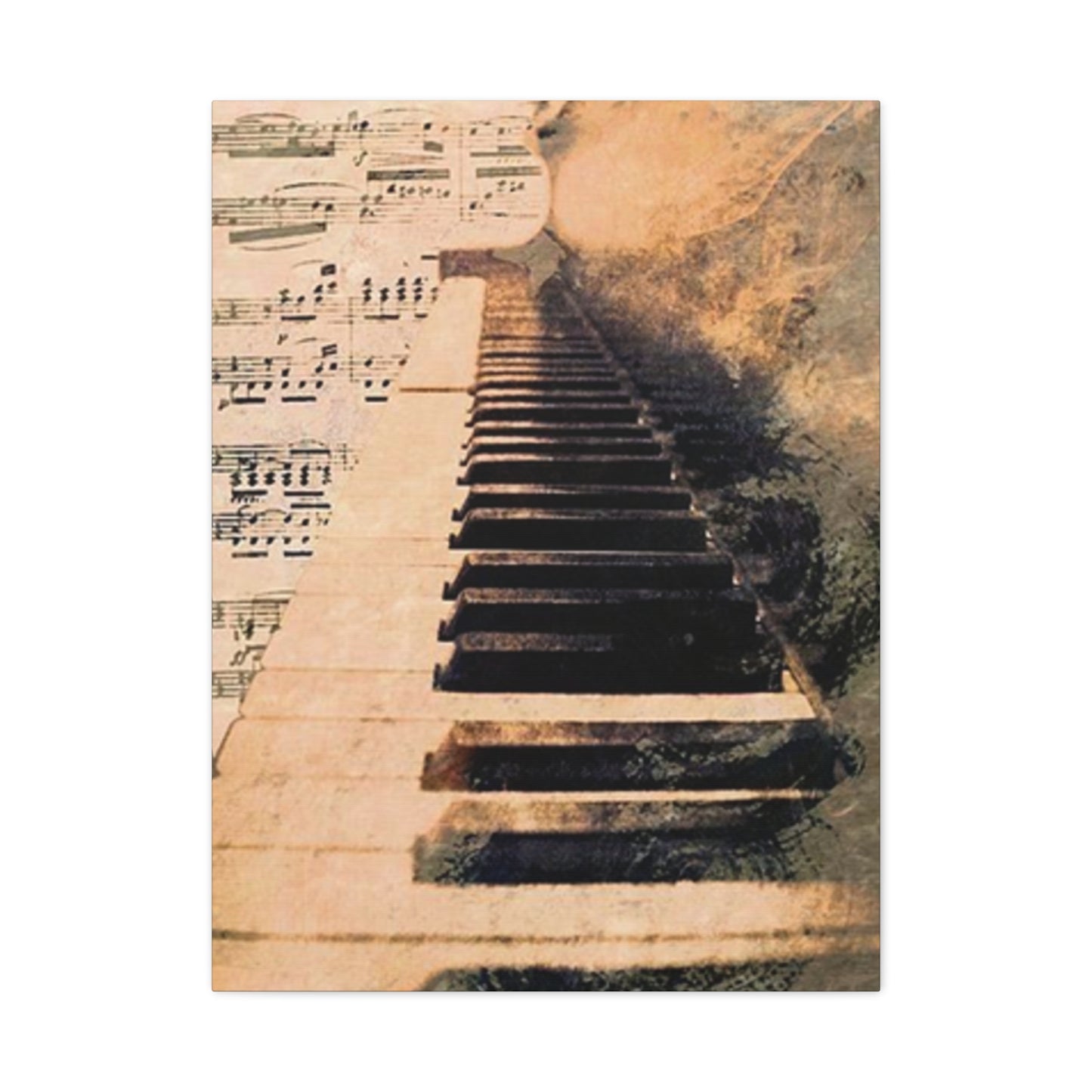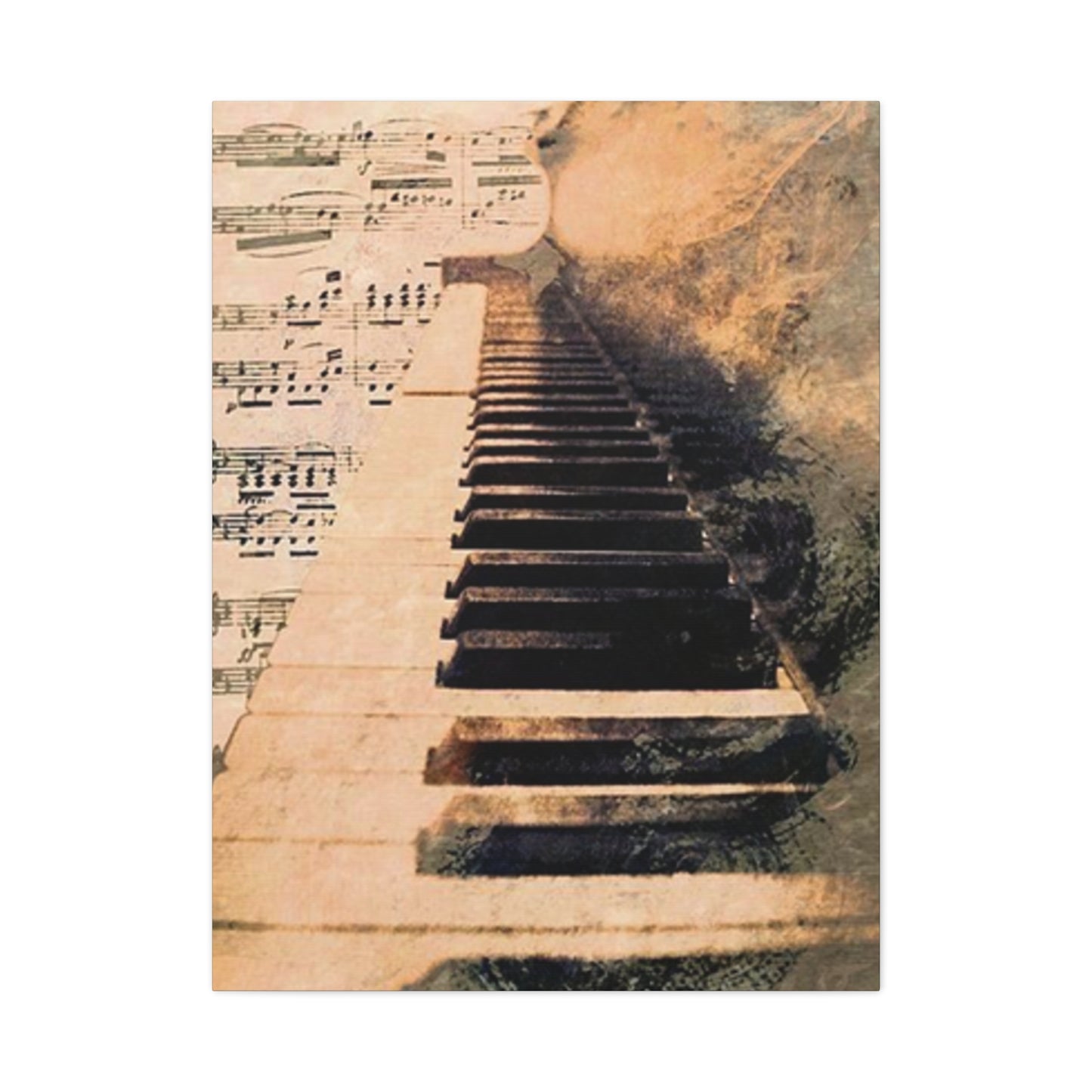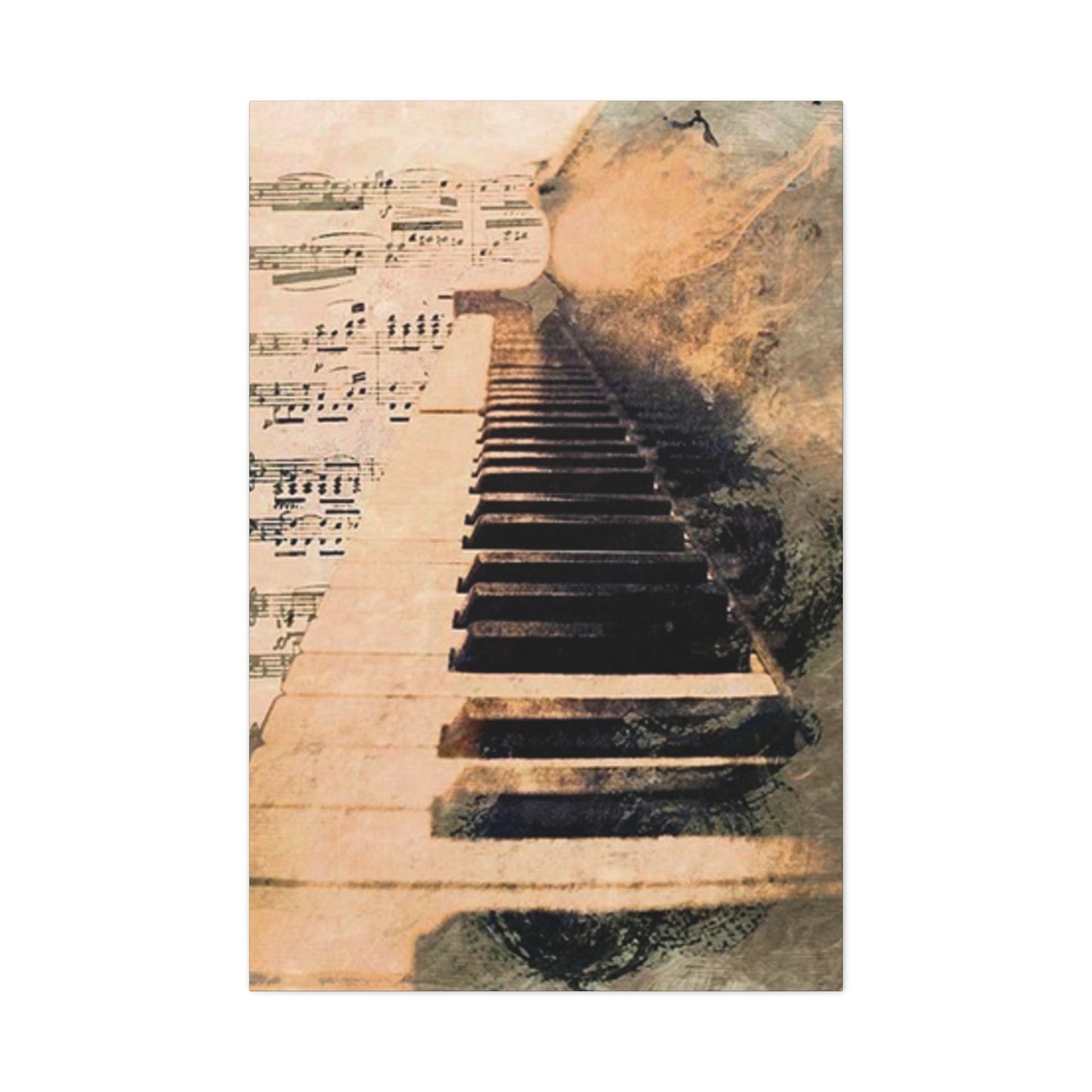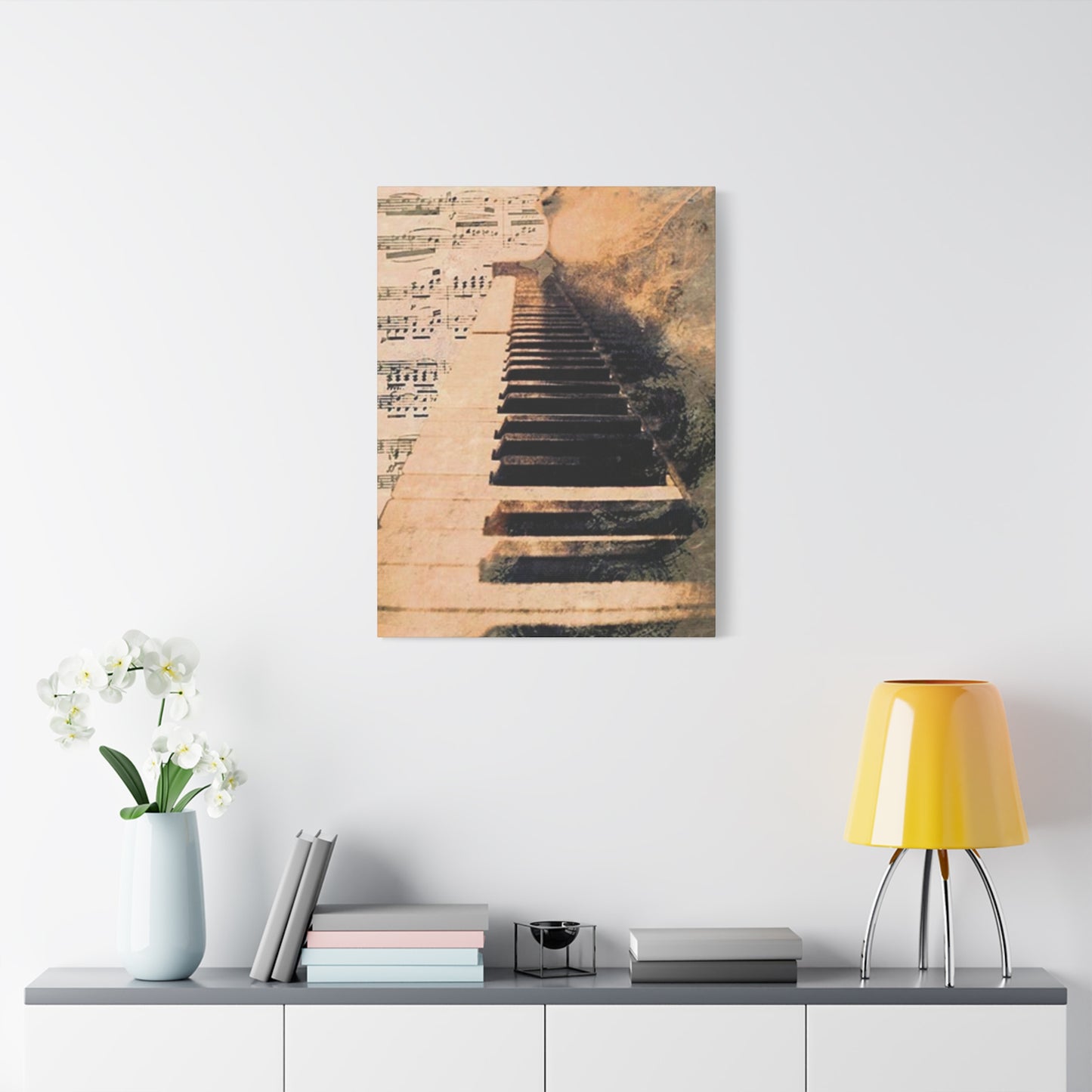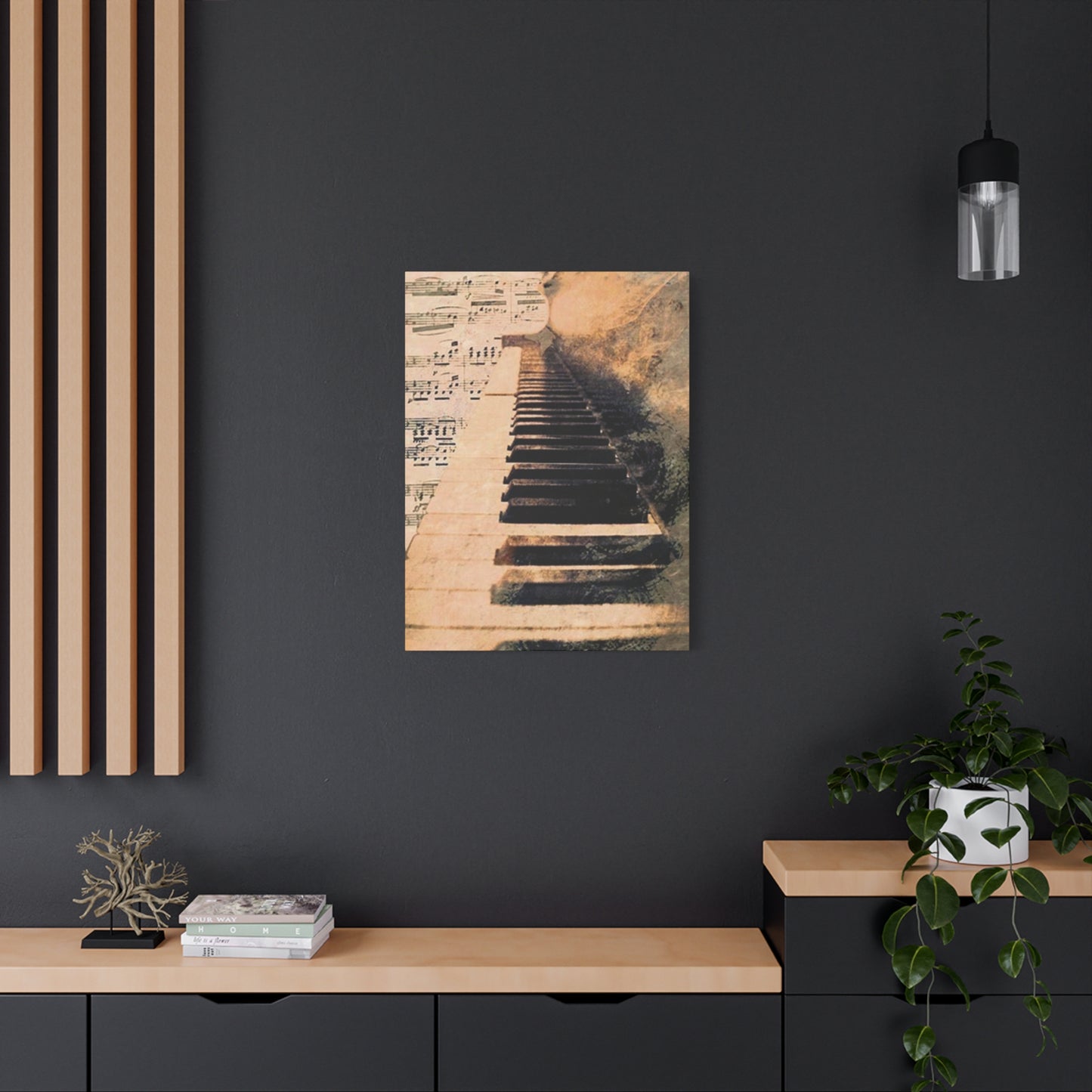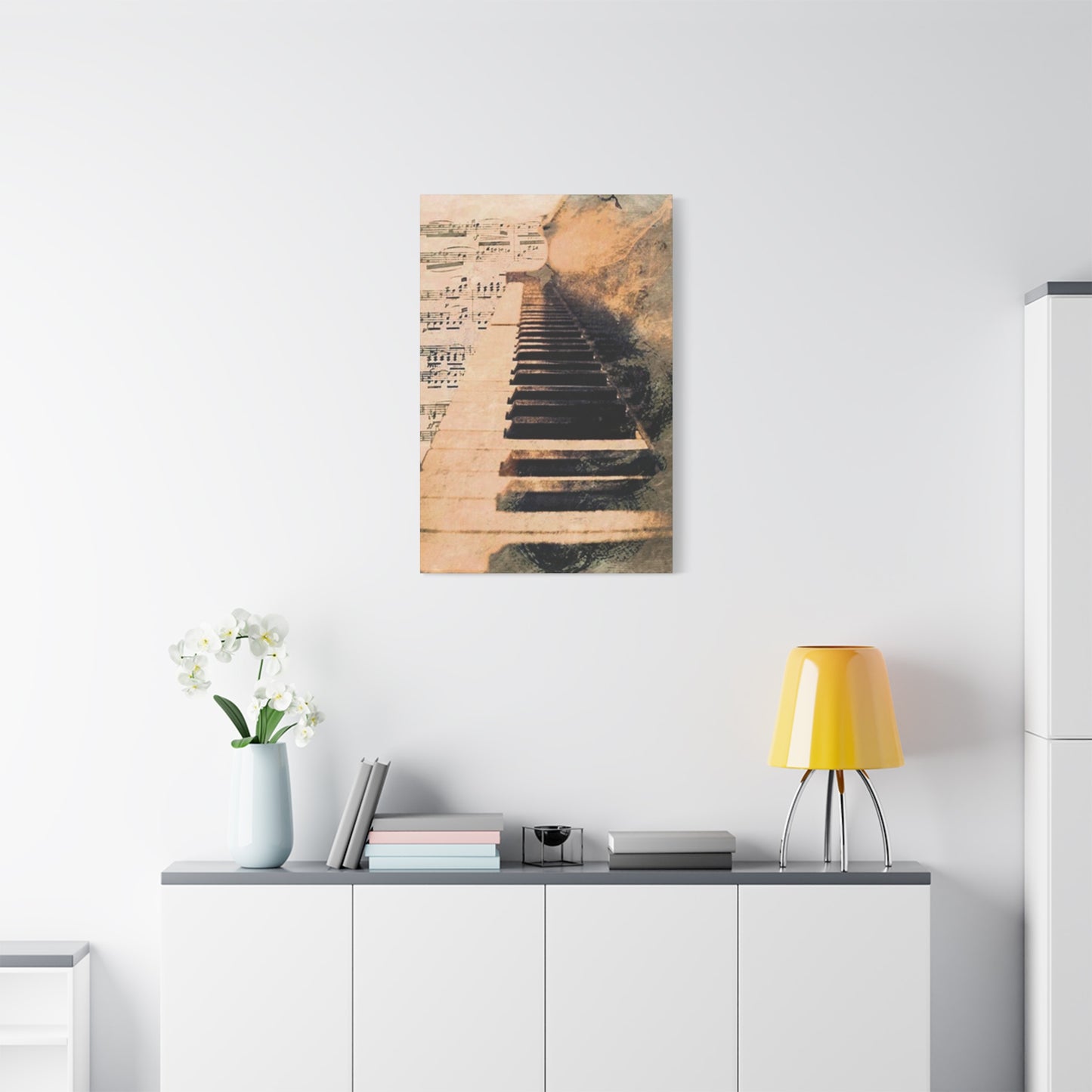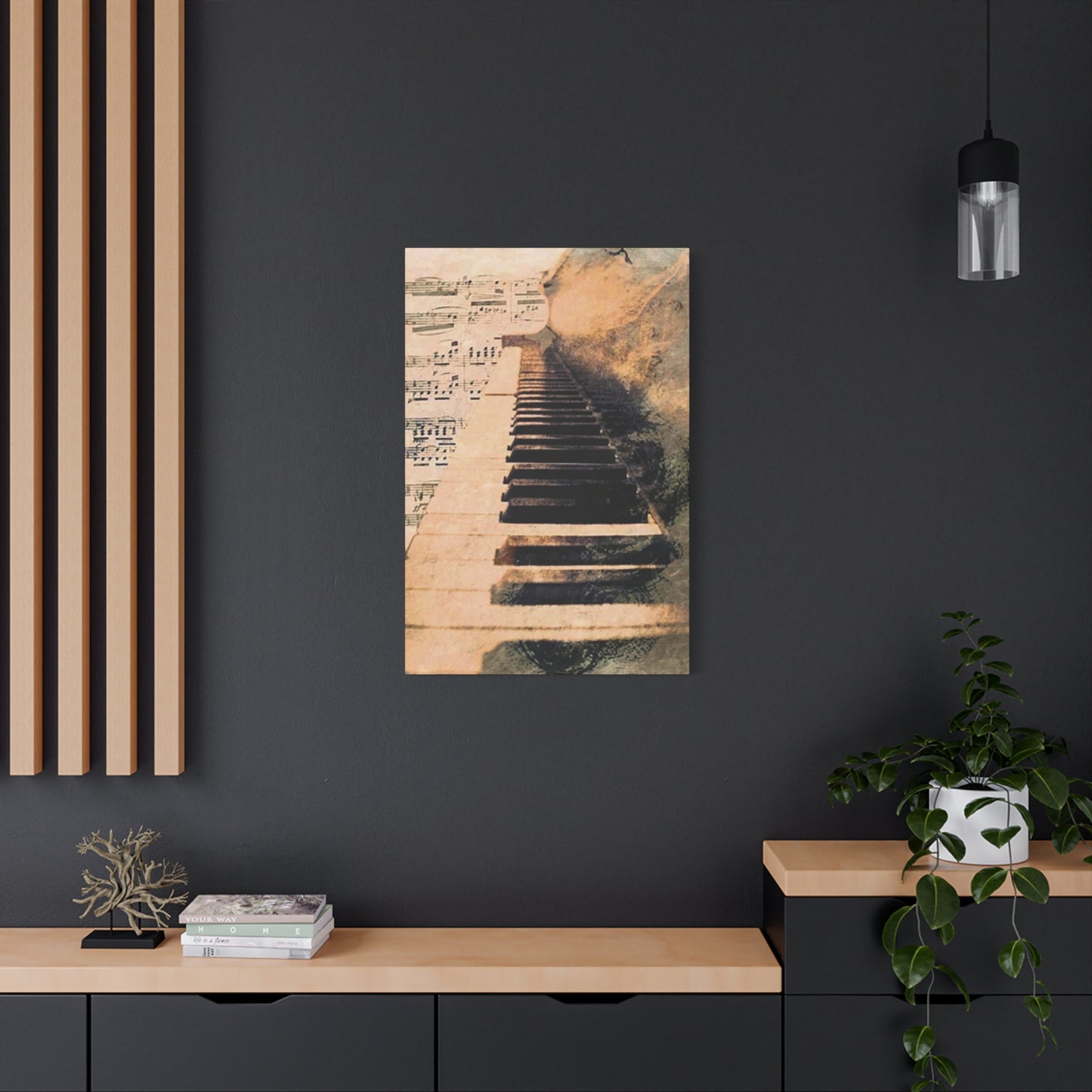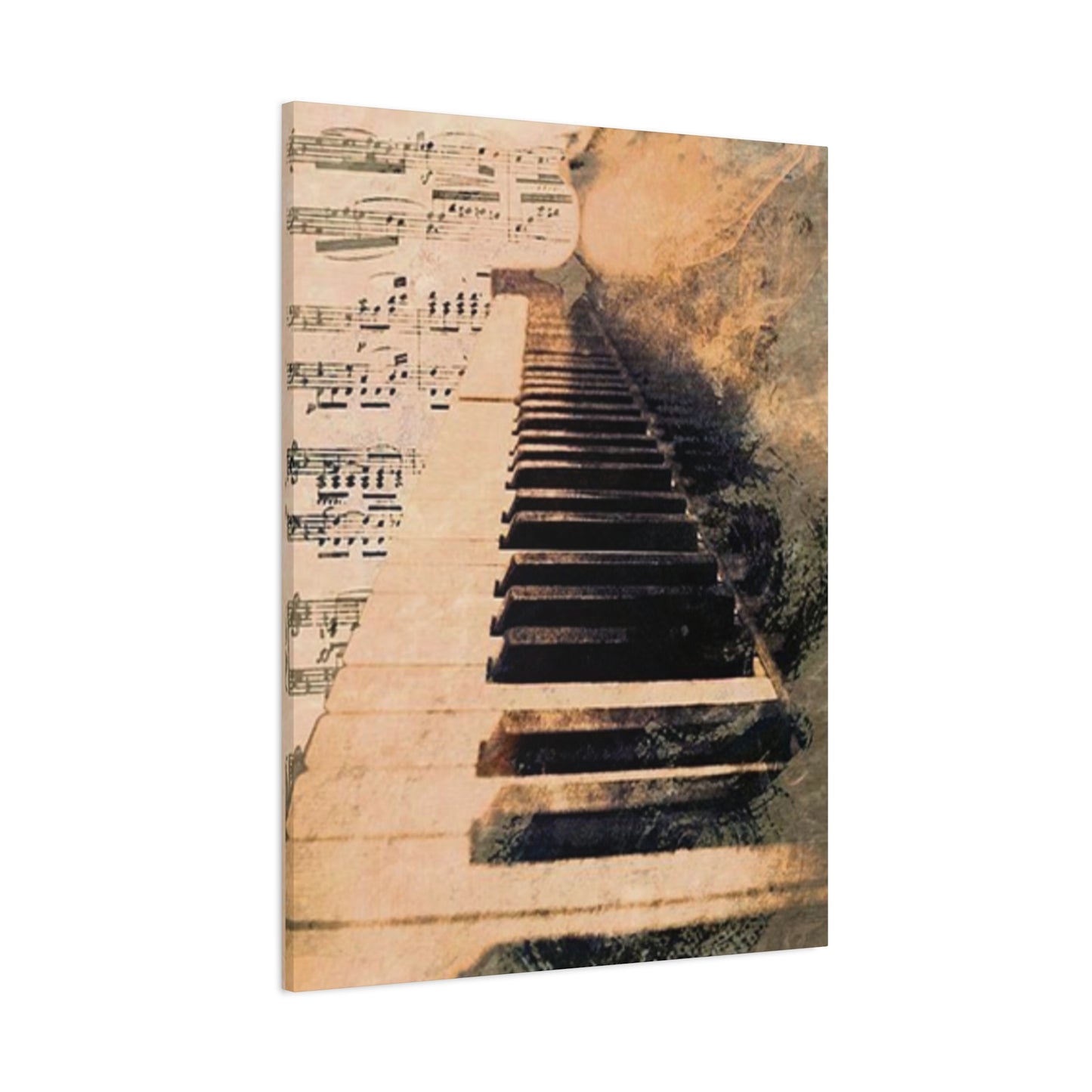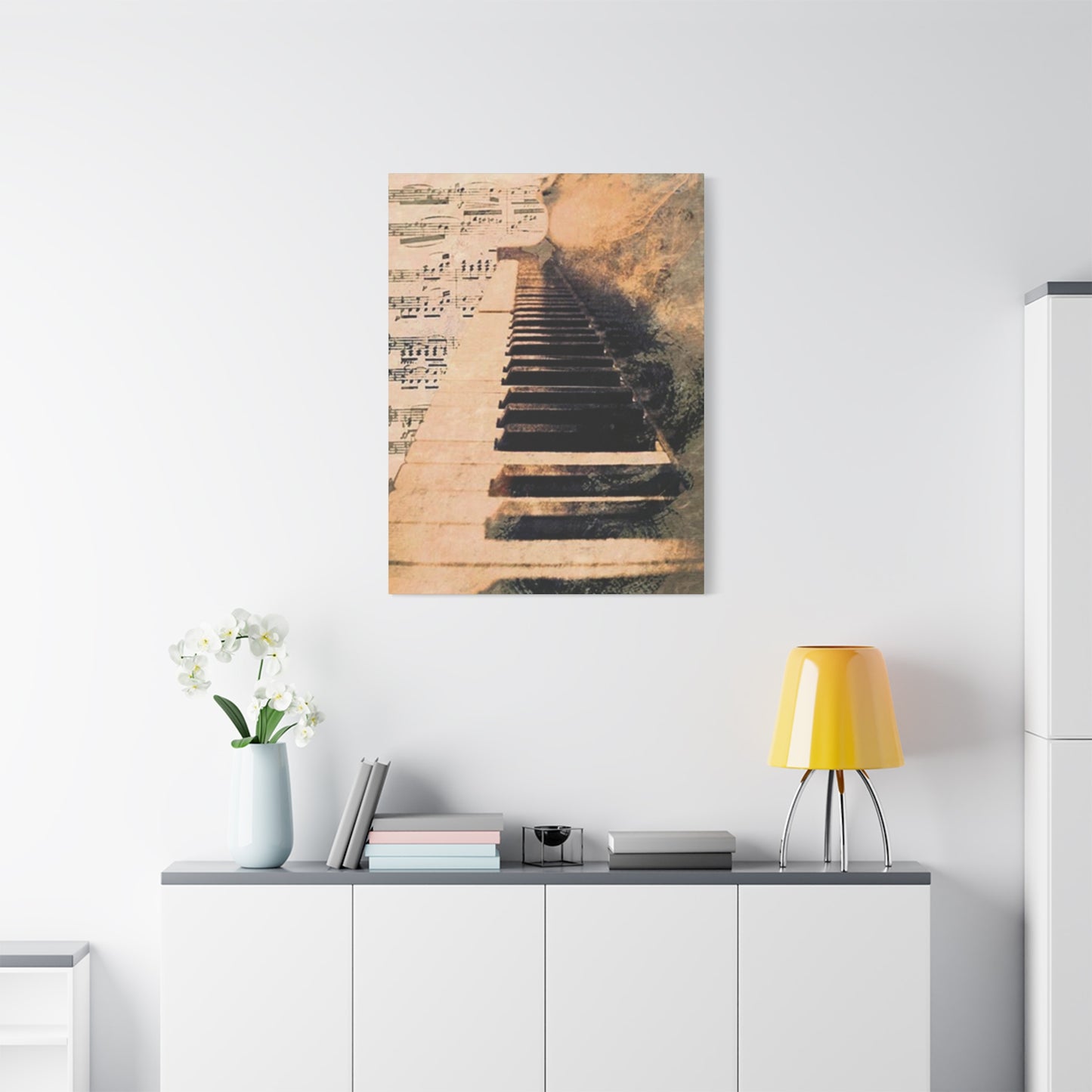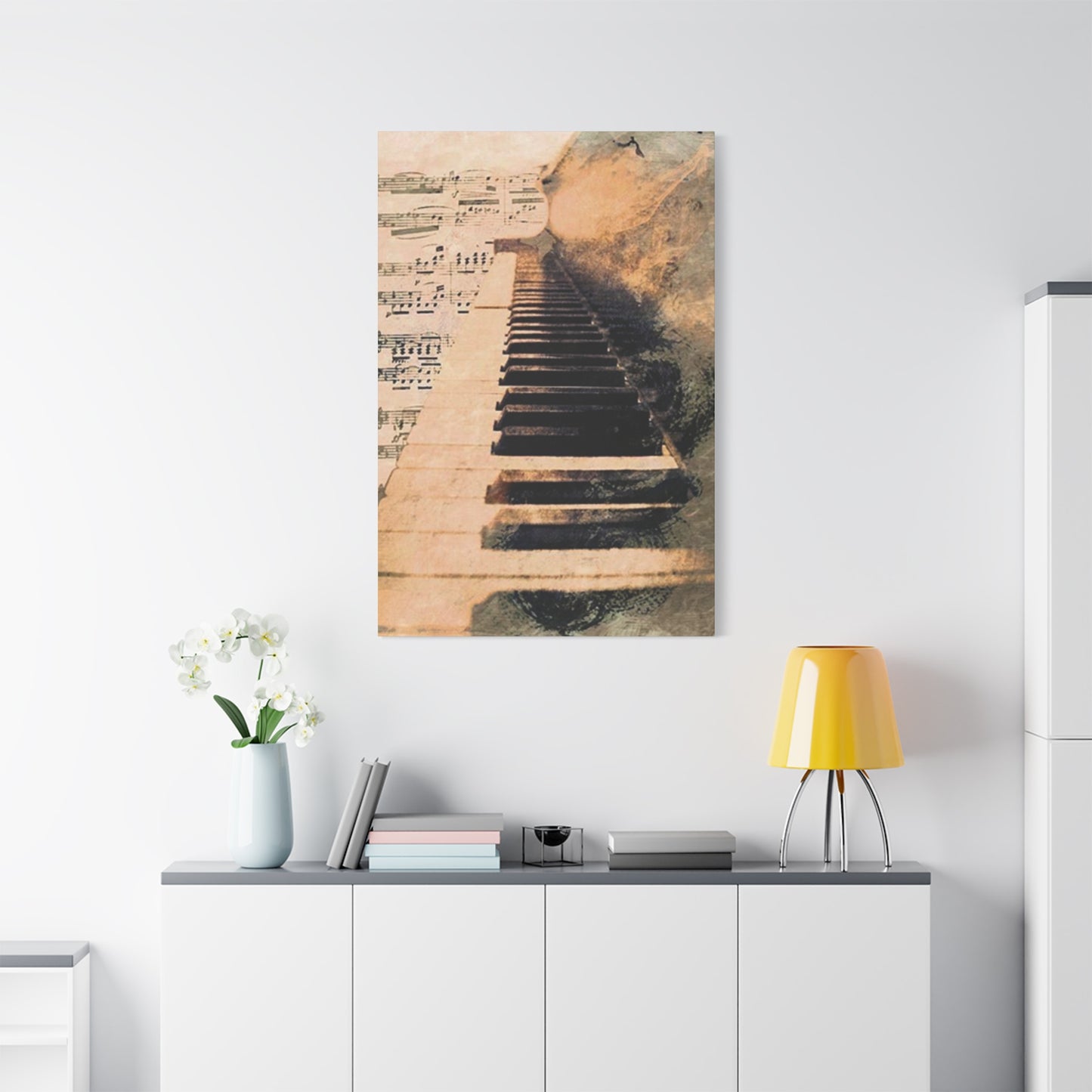Elevating Spaces with Piano Keys Painting Wall Art: A Symphony of Visual Expression
The intersection of music and visual art has long captivated designers, homeowners, and creative professionals seeking to infuse their environments with artistic sophistication. Piano keys canvas art represents a remarkable fusion of musical heritage and contemporary design, offering versatile decorative solutions that resonate with both music enthusiasts and aesthetic connoisseurs. This distinctive form of wall decoration transcends conventional boundaries, creating visual narratives that celebrate the timeless beauty of musical instruments while enhancing modern living spaces with elegance and character.
The piano keyboard, with its contrasting black and white keys arranged in rhythmic patterns, provides endless inspiration for artistic interpretation. From photorealistic renderings that capture every textural detail to abstract compositions that reimagine the keyboard as geometric forms, this artistic genre accommodates diverse tastes and interior design philosophies. Whether adorning residential spaces, professional environments, or educational institutions, these visual pieces serve as constant reminders of music's universal language and its power to transform ordinary rooms into extraordinary sanctuaries.
Musical Wall Décor: Piano Keys Painting
The artistic representation of piano keyboards on canvas has emerged as a sophisticated choice for those seeking to blend musical passion with interior aesthetics. These paintings capture the instrument's essence through various artistic techniques, from realistic depictions that showcase the glossy finish of ivory and ebony keys to impressionistic interpretations that convey the emotional resonance of music itself. Artists employ oil paints, acrylics, watercolors, and mixed media to create depth, texture, and visual interest that commands attention while maintaining versatility across different decorating schemes.
When selecting such artwork for your space, consider how the painting's style aligns with your existing décor. Traditional oil paintings with rich, deep tones complement classic interiors featuring wood furniture and warm color palettes, while contemporary acrylic pieces with bold contrasts suit modern minimalist environments. The brushwork itself tells a story—smooth, precise strokes suggest classical refinement, whereas loose, expressive techniques evoke jazz improvisation and creative freedom.
The psychological impact of displaying musical imagery should not be underestimated. These paintings serve as daily inspiration for practicing musicians, spark conversations among guests, and create atmospheric ambiance that enhances creative thinking. Research in environmental psychology suggests that surrounding oneself with representations of personal interests and passions increases feelings of comfort and belonging within a space. For music lovers, a piano keys painting becomes more than decoration; it transforms into a visual affirmation of identity and values.
Placement considerations significantly affect the artwork's impact. In spaces dedicated to music practice or listening, positioning the painting at eye level creates an intimate connection between viewer and subject. Larger compositions benefit from prominent wall spaces where they can serve as architectural focal points, while smaller works thrive in arrangements with complementary pieces that build cohesive visual narratives. Lighting plays a crucial role—directional spotlights emphasize texture and brushwork, while ambient illumination creates softer, more atmospheric presentations.
The craftsmanship behind quality piano keys paintings deserves appreciation. Professional artists study the keyboard's construction, understanding how keys respond to touch and how light interacts with different surfaces. This technical knowledge informs their creative process, resulting in works that ring true to musicians while appealing to broader audiences. The best examples balance technical accuracy with artistic license, capturing the keyboard's structural beauty while expressing the emotional dimensions of musical performance.
Color palettes extend beyond simple black and white contrasts. Many artists incorporate surrounding environments, showing keyboards in context—concert halls with dramatic lighting, intimate home settings bathed in golden afternoon sun, or abstract backgrounds that suggest sound waves and musical energy. These contextual elements expand the narrative possibilities, allowing viewers to project their own musical memories and associations onto the artwork.
Investment in original paintings versus reproductions depends on budget, authenticity preferences, and long-term collecting goals. Original works carry unique energy and serve as conversation pieces with provable provenance, potentially appreciating in value as artists gain recognition. High-quality reproductions democratize access to piano keyboard imagery, making these aesthetic pleasures available to wider audiences while maintaining impressive visual fidelity when properly executed with archival materials and professional printing techniques.
Gallery-Worthy Piano Keys Canvas Prints
Museum-quality canvas prints have revolutionized access to fine art, enabling art enthusiasts to acquire gallery-caliber imagery without the prohibitive costs associated with original paintings. Piano keys canvas prints exemplify this democratization of art, offering reproductions that capture intricate details, subtle color gradations, and textural nuances with remarkable fidelity. Advanced printing technologies, including giclée processes that utilize archival inks and specialized canvas materials, ensure longevity and color stability that rivals traditional media.
The selection process for gallery-worthy prints demands attention to production quality markers. Examine the canvas material itself—premium cotton or linen blends provide superior texture and durability compared to synthetic alternatives. The weave tightness affects image sharpness, with finer weaves supporting higher resolution details particularly important when reproducing the keyboard's intricate patterns. Stretcher bars should be substantial, preferably constructed from kiln-dried wood that resists warping, with corner braces that ensure structural integrity over decades.
Print resolution represents another critical quality factor. Professional reproductions utilize files with minimum 300 dots per inch resolution, ensuring crisp edges where black keys meet white, and preventing the pixelation that undermines visual impact. Color management throughout the printing process guarantees accurate reproduction of the original artwork's palette, maintaining the subtle grays, warm ivories, and deep blacks that give piano keys their characteristic appearance.
Framing options significantly influence the final presentation. Gallery wraps, where the image continues around the stretcher bars' edges, create contemporary, frameless presentations that suit modern interiors. Traditional framing with complementary moldings adds formality and protection, particularly valuable in high-traffic areas or environments with challenging conditions. Float mounting techniques, which suspend the canvas slightly forward from the wall, create dramatic shadow effects that enhance three-dimensional presence.
Sizing considerations should account for viewing distances and surrounding architectural elements. Large-format prints measuring four feet or more suit spacious areas with generous wall expanses, creating immersive experiences that transport viewers into the artwork. Medium sizes between two and four feet offer versatility, functioning effectively as focal points in average rooms without overwhelming the space. Smaller prints excel in intimate settings or as components within gallery wall arrangements that tell broader visual stories.
The concept of gallery-worthiness extends beyond technical specifications to encompass artistic merit and emotional resonance. Seek prints that showcase thoughtful composition, where the keyboard's placement within the frame creates visual balance and guides the eye through intentional paths. Consider how the artwork's mood aligns with the room's purpose—contemplative, detailed studies suit quiet reading areas, while dynamic, high-contrast images energize social spaces.
Authentication and edition information matter for serious collectors. Limited edition prints with numbered certificates maintain exclusivity and potential investment value, particularly when produced in small quantities with artist signatures. Open edition prints, while lacking scarcity premium, provide accessible entry points for those prioritizing aesthetics over collectibility. Documentation regarding printing methods, materials, and edition size adds transparency and aids future appraisal or resale efforts.
Environmental considerations increasingly influence purchasing decisions. Seek manufacturers committed to sustainable practices, utilizing responsibly sourced materials and environmentally friendly inks. Water-based ink formulations reduce volatile organic compound emissions while maintaining color vibrancy, aligning aesthetic choices with ecological values. Packaging from recycled materials and carbon-neutral shipping options further minimize environmental impact, allowing conscientious consumers to beautify spaces without compromising principles.
Modern Interiors: Piano Keys Wall Art
Contemporary interior design celebrates clean lines, uncluttered spaces, and strategic focal points that anchor rooms without overwhelming minimalist sensibilities. Piano keys wall art aligns perfectly with these modern principles, offering strong graphic elements that satisfy the eye's need for visual interest while maintaining the restraint characteristic of current design trends. The keyboard's inherent geometry—repeating patterns of contrasting rectangles—creates natural rhythm that complements modern furniture profiles and architectural features.
Integration within modern interiors requires thoughtful consideration of scale relationships and color coordination. In spaces dominated by neutral palettes featuring whites, grays, and beiges, piano keys artwork provides subtle variation within the same tonal range while introducing the graphic punch necessary to prevent blandness. The black and white contrast inherent to keyboard imagery offers sufficient visual weight without introducing color complexity that might clash with carefully curated schemes.
Material selections extend the modern aesthetic. Frameless presentations or minimal metal frames in brushed nickel, matte black, or chrome finishes maintain industrial elegance characteristic of contemporary design. Acrylic face mounting, where prints are sandwiched between the canvas and clear acrylic sheets, creates gallery sophistication with enhanced depth and luminosity. Metal prints, transferring images onto aluminum substrates, deliver sleek, modern presentations with impressive durability and unique reflective qualities.
Positioning strategies in modern interiors often emphasize asymmetry and unexpected placements that challenge traditional centering conventions. Consider floating piano keys artwork off-center on expansive walls, balanced by furniture arrangements or architectural features rather than rigid symmetry. Vertical orientations of keyboard imagery create visual lift in rooms with standard ceiling heights, while horizontal formats emphasize width and create calming, stabilizing effects in narrow spaces.
The relationship between artwork and negative space deserves careful attention in minimalist environments. Modern design philosophy embraces emptiness as an active design element rather than leftover space requiring filling. Piano keys art functions most effectively when surrounded by generous breathing room, allowing the eye to appreciate the composition without competing distractions. This approach paradoxically increases the artwork's impact—restraint in placement amplifies presence.
Technological integration represents an emerging frontier in modern interior art. Digital display frames capable of rotating multiple piano keys images provide variety without physical artwork changes, appealing to those who appreciate frequent visual refreshment. Smart home integration enables lighting adjustments that coordinate with music playback, creating multisensory experiences where visual and auditory dimensions harmonize. These innovations respect traditional artistic values while embracing contemporary capabilities.
Textural contrasts within modern spaces often juxtapose smooth, hard surfaces—glass, polished concrete, stainless steel—against strategic soft elements. Canvas naturally provides this textural relief, with woven surfaces introducing organic warmth that humanizes potentially sterile environments. Pairing piano keys canvas with leather furniture, wool textiles, or natural wood accents creates layered sensory experiences that define sophisticated modern interiors.
The cultural narrative embedded in piano imagery adds intellectual depth to modern spaces. Unlike purely decorative abstract patterns, keyboard representations carry historical weight, referencing centuries of musical tradition and cultural achievement. This layering of meaning satisfies the modern desire for substance over superficiality, allowing residents to surround themselves with beauty that also prompts reflection and conversation about music's role in human experience.
Statement Walls with Piano Keys Canvas
Architectural focal points define spatial character and guide visual attention through intentional design strategies. Statement walls concentrate decorative energy on single surfaces, creating dramatic impact that elevates entire rooms beyond the sum of their individual elements. Piano keys canvas artwork naturally lends itself to statement wall applications, offering bold graphic presence that commands attention while maintaining sophisticated elegance suited to various interior styles.
Creating effective statement walls requires understanding spatial proportions and visual weight distribution. The selected wall should possess certain characteristics—sufficient size to accommodate impactful artwork without crowding, visibility from primary traffic patterns and seating areas, and freedom from competing architectural features like windows or doorways that might fragment attention. Corner walls offer unique opportunities, wrapping artwork around angles to create immersive experiences that engage viewers from multiple perspectives.
Scale dramatically affects statement impact. Oversized piano keys canvases measuring five feet or larger establish immediate presence, transforming walls into artistic destinations that anchor rooms and influence all other design decisions. These large-format pieces work particularly well in open-concept spaces where multiple functional areas require visual unification. The keyboard imagery provides recognizable subject matter that reads clearly even at distances, maintaining coherence across expansive interiors.
Color strategy extends beyond the artwork itself to encompass surrounding wall treatment. Painting the statement wall in colors that either complement or contrast with the piano keys canvas amplifies impact through intentional relationships. Deep charcoal or black walls create dramatic backdrops that make white keys luminous, while pristine white surfaces emphasize black key patterns through reversal. Accent colors drawn from subtle tones within the artwork—warm grays, cool silvers, muted golds—establish sophisticated connections between art and architecture.
Lighting design proves crucial for statement wall success. Dedicated artwork illumination using adjustable track lights, picture lights, or recessed fixtures ensures the piano keys canvas receives proper emphasis regardless of natural light availability. Lighting angles affect perception—grazing light from the side emphasizes canvas texture, while direct frontal illumination maximizes color vibrancy. Dimming capabilities allow mood adjustments, transforming the statement wall's character from daytime clarity to evening ambiance.
Furniture arrangements should acknowledge and respond to statement walls rather than ignoring or competing with them. Seating orientations that face or angle toward the piano keys artwork facilitate comfortable viewing and conversation about the piece. Coffee tables, console tables, or benches positioned below the artwork create visual foundations that ground the composition. Maintain sufficient distance between furniture and wall to allow comfortable viewing—approximately one to two times the artwork's diagonal measurement provides optimal perspective.
Complementary décor elements can enhance statement walls without diminishing the primary artwork's dominance. Minimal flanking elements—slender shelves displaying music-related objects, small sculptural pieces echoing the artwork's themes, or subtle botanical arrangements providing organic contrast—add layers of interest. Restraint remains essential; statement walls derive power from focused attention rather than cluttered accumulation.
The psychology of statement walls operates through novelty and emphasis. Humans naturally orient toward prominent visual stimuli, particularly representations of subjects carrying personal significance. For music lovers, entering rooms dominated by piano keys imagery triggers positive associations, activating memories of performances, practice sessions, or emotional musical experiences. This automatic psychological engagement makes spaces feel more personally meaningful and emotionally resonant, transforming houses into homes that truly reflect inhabitants' identities.
Bold Focal Points: Piano Keys Painting
Interior design fundamentals emphasize the importance of focal points—elements that immediately capture attention and establish visual hierarchy within spaces. Piano keys paintings serve as exceptional focal point candidates, combining recognizable subject matter, strong compositional elements, and cultural resonance that engages viewers on multiple levels. The keyboard's linear patterns naturally guide the eye through compositions, creating movement and rhythm that maintain visual interest during repeated viewings.
Selecting paintings for focal point applications requires assessing several artistic qualities. Compositional strength determines how effectively the artwork commands and holds attention. Look for paintings where the keyboard's placement within the frame creates dynamic tension rather than static centering—off-center compositions, diagonal perspectives, or partial views that suggest larger contexts beyond the canvas edges typically generate greater engagement than symmetrical, straightforward representations.
Color intensity and contrast ratios significantly impact focal point effectiveness. High-contrast paintings with pure blacks against bright whites create immediate visual impact that registers across rooms, suitable for large spaces or positions distant from primary viewing areas. Lower contrast works with nuanced grays and subtle tonal variations reward closer inspection, functioning effectively in intimate settings where viewers naturally approach for detailed examination.
Artistic style influences the emotional tone and cultural associations the focal point introduces. Photorealistic paintings communicate precision, technical mastery, and respect for the instrument's physical beauty, appealing to those who appreciate craftsmanship and detail. Abstract interpretations suggest creativity, innovation, and emotional expression, resonating with viewers who value conceptual approaches and personal interpretation over literal representation. Impressionistic styles convey movement, energy, and the ephemeral nature of musical performance, connecting with those drawn to romanticism and atmospheric qualities.
Size relationships between focal point artwork and surrounding elements determine compositional balance. General guidelines suggest focal point art should occupy between one-half and two-thirds of the available wall width, providing sufficient presence without appearing cramped or oversized. However, intentional rule-breaking can yield compelling results—dramatically oversized pieces that dwarf furniture create bold contemporary statements, while surprisingly small works in expansive settings generate intrigue through unexpected scale contrasts.
Vertical versus horizontal orientations affect spatial perception and emotional response. Vertical piano keys paintings create upward visual movement, making rooms feel taller and more formal—particularly effective in entry halls, narrow walls, or spaces with lower ceilings requiring visual lift. Horizontal formats emphasize width and stability, creating calming effects appropriate for living rooms, bedrooms, or above substantial furniture pieces like sofas and credenzas that benefit from horizontal echoing.
The focal point's position within the room influences traffic flow and functional zone definitions. Positioning piano keys paintings opposite entry points creates immediate visual destinations that draw people into spaces, while placement on walls adjacent to entries creates discovery moments as visitors turn to survey rooms. Focal points visible from multiple rooms in open floor plans serve as visual anchors that unify connected spaces through shared artistic reference points.
Maintenance considerations affect long-term focal point satisfaction. Quality paintings properly protected and positioned away from direct sunlight, excessive humidity, or temperature extremes maintain appearance for generations. Regular dusting with soft, dry cloths preserves canvas surfaces, while occasional professional cleaning addresses accumulated environmental contaminants. Investment in focal point artwork warrants protective measures that ensure enduring beauty matching the initial aesthetic impact that justified the purchase.
Living Room Wall Art: Piano Keys Canvas
Living rooms function as homes' social hearts, accommodating diverse activities from family gatherings to quiet relaxation, entertaining guests to personal hobbies. Wall art in these multipurpose spaces must satisfy complex requirements, appealing to residents' personal tastes while welcoming visitors, stimulating conversation without overwhelming, and maintaining visual interest despite daily exposure. Piano keys canvas art addresses these challenges effectively, offering universal appeal rooted in music's cross-cultural significance combined with aesthetic versatility that complements various decorating approaches.
The living room's prominent position within homes elevates wall art decisions beyond mere decoration to expressions of household identity and values. Choosing piano keys imagery communicates appreciation for music, arts, and culture, signaling to visitors that the home prioritizes creative pursuits and intellectual engagement. This symbolic function operates subtly but powerfully, influencing how others perceive residents and how residents perceive themselves within their domestic environments.
Coordinating piano keys canvas with existing living room furnishings requires attention to style continuity and color harmony. In traditional living rooms featuring upholstered furniture, oriental rugs, and wood accents, select canvas prints with warmer tones and classical compositions that respect conventional aesthetics. Contemporary spaces with leather seating, metal fixtures, and geometric patterns benefit from high-contrast, graphic piano keys images that reinforce modern sensibilities. Transitional rooms blending traditional and contemporary elements find middle ground in piano keys art that balances realistic representation with stylistic interpretation.
Seating arrangement relationships significantly impact artwork effectiveness. Above-sofa placement represents the most common living room art location, requiring specific size considerations—canvas width should span approximately two-thirds to three-quarters of the sofa length for proportional balance. Mounting height centers the artwork's midpoint at eye level for seated viewers, typically 50-55 inches from the floor, ensuring comfortable viewing from living room's primary seating positions.
Alternative placement strategies offer fresh approaches beyond conventional over-sofa positioning. Dedicated art walls opposite main seating create gallery-like focal points that encourage contemplative viewing and eliminate concerns about furniture arrangement changes affecting artwork relationships. Fireplace surrounds provide natural focal point locations, though heat and smoke considerations may necessitate protective measures or safer alternative positions. Corner arrangements utilizing multiple piano keys canvases in varied sizes create dynamic compositions that activate underutilized spaces.
Lighting layering enhances living room artwork while serving the room's varied functional needs. Ambient ceiling fixtures provide general illumination for activities and safety, while dedicated picture lights or adjustable track lighting highlight piano keys canvas specifically, creating visual hierarchy that guides attention. Accent lighting from table or floor lamps adds atmospheric dimension during evening hours, with positioning that avoids glare on canvas surfaces while creating depth through shadow play.
The conversational catalyst function of living room art deserves recognition in selection processes. Piano keys canvas naturally prompts questions and comments from guests—whether visitors play instruments, their musical preferences, memories associated with pianos, or aesthetic reactions to the artwork itself. These conversation starters facilitate social interactions, particularly valuable when entertaining new acquaintances or breaking ice in mixed company where common ground may not be immediately apparent.
Seasonal flexibility allows living room art to remain relevant throughout the year. Piano keys imagery transcends seasonal associations, maintaining appropriateness whether rooms are decorated for holidays, adapted for summer lightness, or arranged for cozy winter evenings. This evergreen quality provides consistent visual anchor points around which temporary seasonal decorations can orbit without requiring artwork rotation or storage logistics that burden homeowners.
Office Décor: Piano Keys Wall Art
Professional workspaces profoundly influence productivity, creativity, and psychological wellbeing, with environmental factors including visual aesthetics playing measurable roles in work quality and job satisfaction. Piano keys wall art in office settings serves multiple functions beyond decoration, contributing to professional image projection, personal motivation, and cognitive stimulation that supports focused thinking and creative problem-solving. Whether in corporate headquarters, home offices, or creative studios, keyboard imagery introduces sophistication and cultural references that elevate working environments.
Corporate office applications require balancing personal expression with professional appropriateness. Piano keys artwork satisfies this balance through universal appeal—music appreciation transcends controversial boundaries, making keyboard imagery safe for diverse workplace cultures while avoiding generic blandness that characterizes much corporate art. The black and white palette integrates seamlessly with professional color schemes, neither clashing with brand colors nor appearing too informal for client-facing spaces.
Home office design affords greater creative freedom, allowing more personal artistic choices reflecting individual tastes without committee approval or corporate guidelines. Piano keys wall art in home offices can express homeowners' musical backgrounds, hobbies, or aspirations, creating environments that blur work-life boundaries in positive ways. Surrounding oneself with personally meaningful imagery during work hours maintains connection to broader life interests, potentially reducing the psychological compartmentalization that can make home-based work feel isolating.
Positioning within offices affects both aesthetic impact and functional workflow. Behind-desk placement creates impressive backdrops visible during video conferences, projecting cultural sophistication and attention to environmental quality that influences how colleagues and clients perceive professionalism. Across-from-desk positions provide visual focal points during work breaks, offering momentary mental respites that research suggests improve sustained concentration and reduce cognitive fatigue.
Size considerations in office environments must account for space constraints and viewing distances. Small offices benefit from medium-sized piano keys canvases that establish presence without overwhelming limited wall space or competing with necessary functional elements like filing cabinets, bookshelves, or whiteboards. Larger executive offices or meeting rooms accommodate grander artwork that fills spacious walls and creates impressive atmospheres for important gatherings or client presentations.
The psychological impact of office artwork extends beyond aesthetic pleasure to influence cognitive performance. Studies in environmental psychology demonstrate that personally meaningful imagery in work environments correlates with increased job satisfaction, reduced stress markers, and improved creative thinking. For individuals with musical backgrounds or interests, piano keys art serves as constant reminder of personal identity beyond professional roles, maintaining holistic self-perception that supports psychological resilience and work-life integration.
Acoustic considerations occasionally intersect with office décor decisions. Canvas surfaces provide minimal sound absorption compared to specialized acoustic panels, but stretched fabric does offer slight benefits over hard surfaces like bare walls or framed glass. In particularly reverberant offices, combining piano keys canvas art with strategic acoustic treatment maintains aesthetic appeal while improving sound quality for calls and meetings.
Professional image curation through office décor communicates subtle messages about values, sophistication, and attention to quality. Piano keys artwork signals appreciation for fine arts, educational investment in cultural pursuits, and willingness to create pleasant environments for employees and visitors. These subliminal communications influence business relationships, potentially affecting client confidence, employee attraction and retention, and professional reputation within industries where cultural capital carries weight.
Maintenance simplicity matters in busy professional environments where time pressures limit housekeeping attention. Canvas art requires minimal upkeep compared to alternatives like framed works behind glass that accumulate dust within frames or plants needing regular watering. Occasional dusting maintains appearance, while quality construction ensures long-term durability matching typical office furniture lifespans, avoiding the appearance of neglect that aged, damaged décor conveys.
Minimalist Music Wall Canvas
Minimalism as design philosophy champions simplicity, intentionality, and the elimination of excess, creating environments where every element serves clear purpose and contributes to cohesive aesthetic harmony. Piano keys imagery aligns naturally with minimalist principles through inherent simplicity—the keyboard's clean lines, repetitive patterns, and restricted color palette embody the restraint and visual clarity that define minimalist aesthetics. Minimalist music wall canvas eliminates decorative flourishes, focusing attention on essential forms that communicate directly without unnecessary embellishment.
Selecting appropriate piano keys canvas for minimalist spaces requires rigorous editing and clear artistic vision. Seek compositions stripped to fundamental elements—perhaps focusing on single octaves rather than full keyboards, emphasizing geometric patterns over contextual details, or abstracting the keyboard into pure graphic forms. High-contrast black and white versions without color variations maintain visual purity, while subtle grayscale interpretations offer sophistication without complexity.
Size and placement decisions in minimalist contexts carry heightened significance since fewer elements compete for attention. A single substantial piano keys canvas often serves entire rooms better than multiple smaller pieces that risk cluttering carefully curated emptiness. Precise centering or mathematically intentional off-center positioning demonstrates the thoughtfulness characteristic of successful minimalist design, where apparent simplicity actually results from careful calculation rather than casual arrangement.
Framing approaches should extend minimalist philosophy. Frameless gallery wraps with clean edges suit minimalist sensibilities, eliminating decorative frames that add visual weight. Alternatively, ultra-thin frames in matte black or natural wood finishes provide subtle boundaries without drawing attention from the artwork itself. Metal frames in brushed aluminum or steel introduce industrial notes compatible with minimalist materials preferences.
Color relationships within minimalist spaces require careful consideration. Piano keys canvas naturally provides black and white contrast that can either harmonize with or intentionally disrupt surrounding palettes. In all-white minimalist rooms, keyboard imagery introduces necessary visual variation without color complexity. In spaces incorporating accent colors, the canvas functions as neutral anchor allowing bolder hues elsewhere to command attention.
The concept of negative space reaches philosophical importance in minimalism. Piano keys canvas should float within generous expanses of empty wall, with surrounding void functioning as active design element rather than unused area. This breathing room allows the artwork to resonate fully, creating meditative quality that characterizes successful minimalist environments. Resist temptations to fill adjacent spaces, trusting that less truly creates more impact.
Material quality assumes elevated importance when minimal elements receive maximum attention. In sparse environments, viewers naturally scrutinize visible items more closely than in cluttered spaces where details disappear amid visual noise. Invest in superior canvas materials, premium printing techniques, and expert stretching that withstand close inspection, with flawless execution matching minimalist standards for excellence in all things.
The philosophical dimension of minimalist piano keys art extends beyond aesthetics to lifestyle expression. Minimalism represents conscious rejection of consumer excess and intentional curation of possessions based on genuine value rather than impulse or social pressure. Choosing piano keys imagery that personally resonates demonstrates this thoughtfulness, maintaining connection to music's meaning rather than accumulating decorative items for their own sake.
Maintenance aligns perfectly with minimalist values emphasizing simplicity and efficiency. Canvas requires minimal care, with occasional dusting maintaining appearance without elaborate cleaning rituals or specialized products. This practical ease supports minimalist lifestyle goals of reducing time and energy devoted to possession maintenance, freeing resources for activities and experiences that provide deeper satisfaction than material accumulation.
Piano Keys Painting for Bedrooms
Bedrooms serve as personal sanctuaries where individuals retreat for rest, reflection, and renewal, making wall art selections particularly important for creating atmospheres conducive to relaxation and psychological comfort. Piano keys paintings in bedrooms introduce gentle visual interest without overstimulation, contributing to calm environments that support quality sleep and peaceful waking moments. The familiar, orderly patterns of keyboard imagery provide subtle psychological reassurance, with repetitive elements creating meditative qualities that calm busy minds.
Selecting appropriate piano keys paintings for bedrooms requires considering the space's intimate, personal nature. Unlike public rooms where artwork caters to diverse audiences, bedroom art answers only to residents' preferences and needs. This freedom allows more personal artistic choices reflecting individual musical relationships, whether nostalgic connections to childhood lessons, appreciation for specific musical genres, or aspirational desires to develop musical skills.
Color palette considerations significantly impact bedroom atmosphere. Soft, muted piano keys paintings with gentle contrasts suit restful environments better than high-contrast, dramatically lit images that may prove too visually stimulating before sleep. Warm tones—creams, beiges, soft grays—create cozy intimacy, while cool tones—blues, silvers, slate grays—evoke calm serenity. Consider how bedroom color schemes interact with artwork; harmonious relationships support unified, peaceful feelings while intentional contrasts add energy.
Positioning relative to the bed influences both aesthetic effect and practical functionality. Above-headboard placement creates classic focal points visible upon entering rooms, though this position means residents rarely view the artwork from bed itself. Opposite-bed walls receive maximum viewing time from those relaxing in bed, making this location ideal for paintings that reward prolonged contemplation. Side wall positions work well in smaller bedrooms where space constraints limit options or in rooms with windows or architectural features occupying primary walls.
Size appropriateness differs for bedrooms compared to more public spaces. While living rooms benefit from bold, large-scale works, bedrooms often feel more comfortable with medium-sized paintings that establish presence without dominating intimate spaces. Oversized artwork can feel oppressive in rooms dedicated to rest, whereas appropriately scaled pieces contribute to balanced environments where all elements coexist harmoniously.
Lighting considerations acknowledge bedrooms' varied illumination needs. Daytime natural light reveals artwork's full details and colors, requiring attention to window positioning to avoid direct sunlight that fades canvas over time. Evening artificial lighting should illuminate piano keys paintings without creating glare or harsh shadows that disrupt relaxation. Dimmer switches enable adjustments matching activities—brighter during dressing or reading, softer during wind-down routines approaching sleep.
The psychological function of bedroom art extends to morning routines and evening reflections. Piano keys paintings visible upon waking provide gentle, positive focal points for gathering thoughts before beginning days, while contemplative viewing before sleep offers mental transition from daily activities to rest. For individuals with musical practices, bedroom keyboard imagery serves as nonverbal reminder of commitments and passions, potentially motivating practice even when displayed where instruments aren't present.
Personal narrative elements may factor into bedroom artwork choices more heavily than in shared spaces. Perhaps the painting resembles pianos from meaningful life chapters—grandparents' homes, music schools, first apartments, or venues hosting memorable performances. These personal associations transform generic décor into repositories of memory and meaning, enriching private spaces with emotional depth invisible to visitors but profoundly significant to residents.
Guest bedroom applications balance personal taste with welcoming neutrality. Piano keys paintings offer safe middle ground—culturally sophisticated without polarizing opinions, visually interesting without overwhelming, topically accessible to guests regardless of musical background. This versatility makes keyboard imagery excellent for spaces accommodating diverse temporary occupants with varying aesthetic preferences.
Abstract Piano Keys Canvas Prints
Abstract artistic approaches liberate subjects from literal representation constraints, reimagining familiar forms through conceptual lenses that emphasize emotional resonance, compositional experimentation, and interpretive freedom. Abstract piano keys canvas prints transform keyboards into vehicles for exploring color theory, geometric relationships, and visual rhythm, creating artworks that reference their musical origins while functioning as independent aesthetic objects. This artistic freedom generates diverse expressions ranging from subtle suggestions of keyboard elements to radical reinterpretations barely retaining recognizable connections.
Degrees of abstraction span wide spectrums accommodating varied tastes. Semi-abstract works maintain recognizable keyboard structures while incorporating expressive elements—splashes of color suggesting sound waves, distorted perspectives implying movement, or fragmented compositions evoking musical phrases. Fully abstract pieces abandon representational accuracy entirely, using keyboard patterns as compositional starting points for explorations in pure form, color, and texture where musical associations become optional interpretations rather than obvious subjects.
Color introduction distinguishes many abstract piano keys prints from traditional black and white representations. Artists layer vibrant hues over keyboard forms, perhaps assigning colors to specific keys suggesting synesthetic experiences where sound and color merge. Blues might represent lower registers, reds signal higher octaves, or entire chromatic rainbows cascade across keyboards in visual music. These color choices dramatically expand decorating possibilities, enabling coordination with specific interior color schemes impossible with strictly monochromatic works.
Compositional innovation characterizes successful abstract piano keys art. Rather than straightforward frontal views, abstract approaches might show keyboards from unusual angles—bird's eye perspectives revealing patterns invisible from playing positions, extreme close-ups abstracting individual keys into monumental forms, or multiple superimposed keyboard images creating complex layered compositions. These fresh perspectives maintain viewer interest during repeated viewings, revealing new details and relationships that emerge gradually rather than exhausting visual possibilities quickly.
Textural experimentation adds dimensionality to abstract canvas prints. Digital manipulation or traditional painting techniques create surfaces that transcend smooth photographic realism, incorporating brush strokes, palette knife marks, or digital effects suggesting depth and tactile quality. Some abstract works emphasize keyboards' physical materials—glossy reflective surfaces of polished keys, aged patinas of antique instruments, or weathered textures of neglected pianos reclaimed as artistic subjects.
Interpretive openness represents abstract art's essential appeal. Unlike representational works that communicate relatively fixed meanings, abstract piano keys prints invite personal interpretation and emotional projection. Viewers bring individual associations, memories, and feelings to encounters with abstract imagery, creating unique experiences where artwork's meaning remains fluid and personal rather than dictated by artists' specific intentions. This participatory dimension makes abstract pieces particularly engaging for households with multiple occupants whose interpretations may differ yet all remain valid.
The relationship between abstraction and musical abstraction creates interesting philosophical parallels. Music itself operates abstractly, communicating through sound patterns that lack literal representation yet convey profound meaning and emotion. Abstract visual representations of musical instruments acknowledge this shared territory where meaning transcends literal description, requiring interpretation, feeling, and personal engagement rather than passive recognition. This conceptual alignment makes abstract piano keys art particularly appropriate for music lovers who appreciate art's ability to operate beyond surface appearances.
Contemporary relevance positions abstract piano keys prints within current artistic discourse. While representational keyboard images carry historical weight, abstract interpretations feel distinctly contemporary, engaging with modern art movements and theoretical frameworks that dominate museums and galleries. For collectors interested in art's cutting edge or residents seeking décor that signals cultural currency, abstract approaches offer sophistication beyond conventional decorative imagery.
Versatility in various interior contexts makes abstract piano keys prints practical despite artistic adventurousness. The abstraction softens specific style associations, allowing integration across design periods from mid-century modern to contemporary minimalism. Color flexibility enables matching existing palettes, while compositional variety accommodates different spatial proportions and architectural features. This adaptability paradoxically makes abstract works more universally applicable than some realistic representations carrying stronger stylistic identities.
Music Studio Wall Art: Piano Keys Canvas
Dedicated music spaces demand wall art that resonates with rooms' specialized purposes while enhancing environments conducive to creative practice, recording, and musical exploration. Piano keys canvas in music studios serves functional purposes beyond aesthetics—inspiring practicing musicians, signaling space dedication to musical pursuits, and creating visual breaks during intensive practice sessions that prevent mental fatigue. The keyboard's symbolic association with music theory, composition, and performance makes its imagery particularly meaningful in contexts where musical activities occur daily.
Studio types vary significantly, requiring different decorative approaches. Home practice studios benefit from motivational imagery that encourages regular engagement during moments when discipline flags. Recording studios need visually interesting backgrounds for video content while maintaining acoustic considerations that prioritize sound quality over purely visual appeal. Teaching studios require appropriate imagery for students ranging from children to adults, with keyboard representations offering universal recognition across age groups and skill levels.
Inspirational function elevates studio wall art beyond passive decoration. Piano keys canvas reminds musicians of their instruments' beauty and complexity, reinforcing commitment during challenging practice periods. For multi-instrumentalists, keyboard imagery centers focus on fundamental music theory visible in piano key arrangements. Students benefit from seeing keyboards between lessons, maintaining subconscious connection to upcoming practice obligations and musical goals.
Educational applications incorporate piano keys canvas into pedagogical strategies. Detailed, accurate keyboard representations serve as reference materials for discussing music theory, key signatures, chord construction, and scale patterns. Teachers point to canvas prints during explanations, making abstract theoretical concepts visually concrete. Large-scale keyboard images enable group instruction where multiple students simultaneously view fingering positions or note relationships discussed during lessons.
Acoustic treatment considerations affect studio wall decisions. While canvas provides minimal sound absorption, it offers more acoustic benefit than hard reflective surfaces like bare walls or glass. Studios requiring serious acoustic control can combine piano keys canvas with strategically placed acoustic panels, maintaining visual interest while addressing sound quality needs. Some manufacturers produce hybrid products printing keyboard images directly onto acoustic foam panels, merging aesthetic and functional requirements.
Conclusion
Piano keys painting wall art offers a unique and captivating way to elevate any interior space, seamlessly blending the timeless elegance of music with the power of visual expression. More than just decoration, this art form embodies a symphony of creativity, rhythm, and harmony that resonates deeply with both musicians and art enthusiasts. Whether displayed in a cozy living room, a vibrant studio, a sophisticated office, or a public gallery, piano keys paintings inject energy, sophistication, and emotional depth into any environment.
At the heart of its appeal lies the universal recognition of the piano as an iconic instrument. The black and white keys symbolize more than just notes; they represent the foundation of musical expression, discipline, and passion. Artists who depict piano keys in their paintings capture this essence, emphasizing the instrument’s elegant simplicity and boundless creative potential. This makes piano keys wall art a versatile piece that effortlessly enhances diverse interior design styles—from modern minimalism and industrial chic to classic traditional or eclectic décor.
One of the most striking features of piano keys paintings is their ability to visually mimic the flow and rhythm of music. Through careful use of contrast, shading, and composition, the artwork creates a sense of movement and dynamism that mirrors the melodies produced by the piano. This visual rhythm invites viewers to engage on a sensory level, evoking the feeling of hearing music even in silence. Some artists further elevate this experience by incorporating bold splashes of color, abstract elements, or textured brushwork, which can evoke the emotional intensity and improvisational spirit of a live piano performance.
Beyond aesthetics, piano keys painting wall art serves as a powerful symbol of creativity, inspiration, and the universal language of music. It reminds us that artistic expression transcends boundaries, connecting people through shared emotions and stories. For musicians, having piano keys art in their practice or performance spaces can be deeply motivating—serving as a visual muse that encourages dedication, passion, and continual growth. For non-musicians, the artwork offers an accessible and stylish way to appreciate music’s cultural and emotional significance, enriching their everyday surroundings with meaning and beauty.
Additionally, piano keys wall art is incredibly adaptable in terms of scale and presentation. A large-scale canvas can become the dramatic centerpiece of a room, commanding attention and setting the tone with its bold presence. Conversely, a series of smaller paintings or prints arranged gallery-style can create a harmonious narrative or rhythm across a wall, offering visual interest and balance. This flexibility allows homeowners and designers to tailor the artwork to their specific space and aesthetic goals, whether they aim to create a tranquil, inspiring retreat or a vibrant, energetic atmosphere.
The monochromatic palette typical of piano keys paintings offers further advantages in interior design. The classic black-and-white scheme complements almost any color palette, making it easy to integrate with existing décor. At the same time, it can provide a striking contrast in colorful rooms or blend seamlessly into neutral, understated environments. This versatility ensures that piano keys art remains relevant and appealing, no matter the evolving tastes or trends in design.
Moreover, incorporating piano keys painting wall art can transform a space into a meaningful sanctuary—a place where art and music coexist to nurture creativity, reflection, and emotional well-being. It invites residents and visitors alike to pause, feel inspired, and connect with the deeper rhythms of life. The artwork’s presence adds not only beauty but also a sense of cultural sophistication and intellectual richness to your home or workplace.
In conclusion, Piano Keys Painting Wall Art transcends simple decoration to become a profound celebration of music, creativity, and artistic expression. By introducing this artwork into your interior design, you bring a symphony of visual and emotional elements that enrich your environment in countless ways. From its universal symbolism and aesthetic versatility to its ability to inspire and evoke emotion, piano keys art offers a timeless, elegant, and meaningful addition to any space. Whether you are a passionate musician, an art lover, or simply someone who appreciates the beauty of creative expression, piano keys painting wall art is a perfect choice to elevate your surroundings and celebrate the harmonious interplay of sight and sound.

















